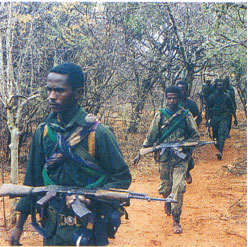|
NewAfrican
(July/August
2001)
By
Peter Strandberg
The
Oromo Liberation Movement (OLF) which claims to represent
the 28 million people of Oromo (who make up nearly half
of the total population of Ethiopia), has, for the past
year, intensified its armed struggle against the government
in Addis Ababa. Created in 1973, the OLF fought for
years alongside the Tigrian Peoples Liberation Front
(TPLF) and the Eritrea Peoples Liberation Front (EPLF)
against the government of President Mengistu Haile Miriam,
which finally fell in May1991.
 |
|
OLF
in Action
|
Today,
while the TPLF and EPLF dominate the governments in
Ethiopia and Eritrea respectively, the OLF is back in
the "bush" (it has in fact been in the bush since June
1992) fighting their old comrades-in--arms who now rule
in Addis Ababa.
The
bush war has now spilled over into neighboring Somalia
and Kenya and could lead to another big war in the Horn
of Africa.
The
situation on the Ethiopia Kenyan border is sensitive.
In the past few months, Ethiopian soldiers and their
militia have crossed the border into Kenya, killing
several Oromo civilians and nine Kenyan policemen who
tried to defend them.
On
a recent trip to OLF bases on the Ethiopian side of
the border, our truck was attacked by bandits who sprayed
the side of the truck with bullets. We were lucky to
escape. Later, we heard from the local police that the
bandits got so frustrated after losing our truck that
they killed two passing women, on their way to the market
In
another Ethiopian attack over the border further east,
the village of Gurar was torched, leaving over 3,300
people without homes.
Last
year, the Ethiopian troops undertook about 26 cross-border
operations, leaving 40 civilians dead and thousands
homeless. About 15,000 cattle were stolen and taken
across to Ethiopia.
It
is easy to understand why nobody has cared to chronicle
the suffering of the Oromo in northern Kenya and inside
Ethiopia, and why no foreigner has been with the OLF
guerrillas since they went back into the bush in 1992.
Guerrilla
base
We
finally reached our destination late at night, a completely
camouflaged guerrilla base in the middle of the bush,
near the mountain range called the Mega Escarpment.
There had been no rain in this area for the last six
years. In the morning, I met Bikilcha Sangi, the OLF
commander of the Southern Front.
"We
are fighting the Tigray army on four fronts, here in
the south, in the west, east and in the central highlands,"
Commander Sangi said. "From a very bad situation back
in 1992 when the TPLF could use Eritrean troops against
us, we organized ourselves and have grown in strength
day by day."
The
OLF has about 17,000 men spread out in a large area,
from the borders of Sudan and Somalia down to the Kenyan
border Close to 8,000 of them are engaging the well-armed
Ethiopian army on the southern front.
Reports
that the Eritrean government is helping the OLF could
mean that the hush war in Ethiopia could explode and
involve both Somalia and Kenya.
Some
4,000 Ethiopian troops have reportedly crossed into
Somalia supporting the Rahanwein Resistance Army in
fighting warlords and OLF guerrillas in the east.
Veterans
Outside
a small border village, I met two old members of the
OLF - Tula Dube, 79, and Wako Kanchora, 59. They have
been with the OLF since its creation in 1973.
Wako
tells me: "We were friends to both the TPLF and the
Eritreans fighting Mengistu, but after the victory in
1991 the TELF started to kill and arrest our members
in Addis Ababa, knowing that they would never be able
to win a free election in the country, being a minority
compared to us Oromos."
So
back into the bush, they went. Today, the two veterans
are optimistic that they will live to see "Oromia" liberated,
and a new government in Addis Ababa. Oromia was once
a mighty kingdom in what is now Ethiopia, stretching
from Einfine (now Addis Ababa) in the north, to the
Somali border arid Ogaden in the east, to Sudan and
the Kaffa region, and into northern Kenya.
The
Oromo migrated north into Southern Ethiopia in the early
1600s, as slave raiders decimated the original population.
Their monarchy was conquered by Emperor Menelik's expanding
empire in what would become Ethiopia.
During
Emperor Haile Seaside’s reign, the Oromo organized a
movement to fight for their freedom and this saw the
birth of the OLF. Today, one of Africa’s biggest tribes
has no influence at all in its home country.
Says
Hakule Galma, an old woman who has lived on the Kenyan
side of the border for years: "We have lost everything
in Ethiopia and now they come again killing our people
and stealing our small belongings. Kenya does nothing
to protect us and the world is not giving us any help."
From the look of things, the end, of her nightmare is
nor nigh.
|


